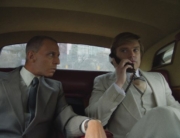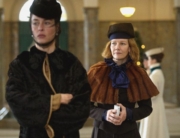
This biopic begins in Victorian England, when the streets were sooty and filthy in the wake of the Industrial Revolution, and ends in the late 1930s. It features an absentminded artist who repeatedly fails to support his family of spinster sisters, a death from terminal breast cancer, schizophrenia, a surprising ascent to fame when the aforementioned artist chooses to draw cats to bury his grief, a mental breakdown, and a surprise rescue from destitution. This “true story” (according to the opening credits) seems to contain a fair amount of darkness and strangeness. It would be fair, based on the above summary, to call it bizarre.
However, after watching The Electrical Life of Louis Wain, you almost wouldn’t know it.
The time line traces Louis Wain’s life from 1881, when he (Benedict Cumberbatch) meets the love of his life, Emily (Claire Foy), his sisters’ governess, until his last days, when his friends, in an act of philanthropy, assemble a public fund in his name. Broadly speaking, the film’s focus is on the wild oscillations of his fortune, in his private life and his career. The music is alternately jaunty and tear-jerking, and the acting is lively. While the sets may depict a few inhospitable locations, they are often beautiful—or, in the case of a decrepit hospital, an obvious film set.
It is no exaggeration to say that this story is told in the broadest possible strokes. If there is an opportunity for an unearned, emotional swell of music, it is taken. The same goes for the heartfelt one-liners, multiple slow-motion sequences (of solemn crowds, dancing families), and multiple shots in which Cumberbatch stares meaningfully into space as if Louis’s mind is racing with strange and brilliant thoughts. It is, rather unfortunately, told like a heartwarming family film.
Most fatally, the director and screenwriters seem barely interested in the singularity of this story, and some of its most striking details are somewhat glossed over. For instance, cats. Yes, we see them. However, according to this movie, Louis helped shift public opinion in favor of the animals, and thus they became pets. We scarcely witness any of the previous negative attitudes, and cats themselves, what makes them unique and arresting, are barely dealt with.
The same goes for Louis’s art depicting them dressed up like humans, dancing and attending balls, holding cups of tea, and the like. The drawings are sickeningly cute, and while the contrast to the misfortune of his life is alluded to, it is not convincingly portrayed. His drawings, and his thinking, become stranger, the former turning genuinely psychedelic and the latter involving speculations on the “electricity” cats give off that would help mankind if only it could be harnessed.
Although Louis struggles with frightening visions (a crowd full of humans with cat heads, for instance), the film still feels too wholesome to contain him. More than once, someone mentions that Louis brought people joy in his darkest time, but this darkness is so fleetingly depicted that the oddness of this story is not brought to life.
Its saving grace? A cameo from Nick Cave as H.G. Wells. He looks nothing like the author, but it’s an amusing touch.






Leave A Comment